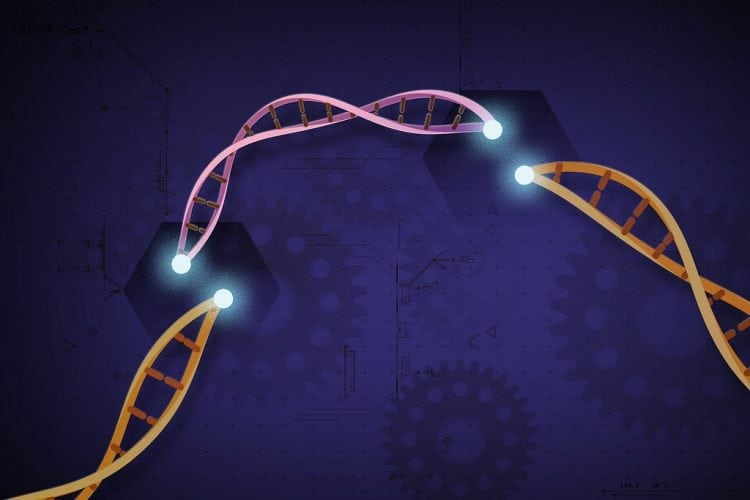
A team of bioengineers at the University of Illinois have reported that they have successfully created a method of gene editing that is safer and more efficient than the widely used CRISPR-Cas9 procedure. The technique, dubbed CRISPR-SKIP by its creators, improves upon existing CRISPR technology by allowing the replacement of single bases of DNA, instead of relying on the breaking of DNA strands to disable genes.
By modifying a single base on DNA, researchers can make pre-mRNA transcript—the “blueprint” for protein production—”skip” certain sequences when encoding the instructions from DNA to create proteins. In other words, instead of cutting the DNA up after it has already been created to create new DNA sequences that encode different proteins, CRISPR-SKIP lets mRNA transcript “ignore” the instructions from certain DNA bases when creating proteins.
The new technique is notable as researchers claim that it is a safer and more precise way of editing genetic code than conventional methods. Primarily, CRISPR-SKIP does not involve the relatively harsh physical alteration of DNA strands like CRISPR-Cas-9, so it is less likely to induce harmful deletions or mutations that can cause cancer. The technique also allows researchers to modify the expression of single DNA bases, an extremely precise task.
CRISPR-Cas9 vs. CRISPR-SKIP
“CRISPR” (an acronym for Clustered Regularly Interspaced Short Palindromic Repeats) are a family of RNA sequences of repeating bases found in bacteria and archaebacteria. CRISPR sequences contain bits of DNA from viruses that have attacked the bacteria in the past. Essentially, these strands of DNA are like “mugshots” of viruses and allow bacteria to identify the viruses in subsequent attacks. Once the harmful viral sequence is identified, the bacteria will send out an enzyme called Cas-9 which can destroy the potential harmful viral DNA. Incidentally, human beings have also developed a viral defense mechanism that works somewhat similarly.
CRISPR-Cas9 gene editing techniques work by exploiting this natural prokaryotic defense system. Scientists create a synthetic “guide RNA”, an artificially created strand of RNA that tells Cas-9 enzymes where to go. The Cas-9 enzyme then goes and breaks the DNA strand at the location specified by the guide RNA. When the body goes to fix this double-strand break (DSB), it ends up disabling (deleting) the gene located at the breaking point. The ability to create synthetic guide RNA makes it so researchers can directly edit virtually any section of DNA.
The rise of CRISPR-Cas-9 based gene-editing techniques in the 21st century has revolutionized the world of biotechnology, giving scientists the ability to directly edit individual strands of DNA however they please. Unfortunately, the spread of the technology has been somewhat of a double-edged sword. It has recently been discovered that CRISPR-Cas9 gene editing techniques are not as safe as thought to be, potentially leading to deleterious mutations of the genetic code and an increased risk for conditions such as cancer.
Enter CRISPR-SKIP. CRISPR-SKIP works by utilizing what are known as “exons” and “introns.” Eukaryotic genes are subdivided into sections called exons which contain the bulk of our genetic information. Between the exons are sections known as introns, sequences of DNA that do not seem to do anything in particular. Normally, when transcribing genetic code, pre-mRNA transcript encodes the exons while skipping over the introns and forms into mature mRNA transcript containing the proper code.
The researchers noticed that virtually every intron sequence in DNA terminates with a guanosine (G) base. They discovered that modifying this single base into adenosine (A) would interrupt the mRNA transcript encoding, causing it to skip over subsequent exon sections. In other words, modifying the single guanosine base tricks the pre-mRNA transcript into thinking that an exon is an intron. When writing instructions for the production of proteins, the mRNA-transcript skips over the selected exon sequence, and the produced protein is modified accordingly. Effectively, the procedure “deletes” the exon by preventing it from being encoded into mRNA transcript.
CRISPR-SKIP does not work by breaking apart strands of DNA but by modifying a single base to affect protein production. This makes it less likely to cause harmful deletions or additions that can result from the stochastic repairing of broken DNA strands. Moreover, the procedure allows for extremely precise gene-editing at the level of single bases.
As of now, the technique has some limitations. The current state of the technology requires that the intron sequences that are modified in order to induce exon skipping during transcription have to have a particular chemical character, one that not all intron sequences have. The team is optimistic though stating that more research will expand the window of applicability for CRISPR-SKIP. The researchers estimate that with the 4 single-base editor mechanisms they have currently developed are able to target 118,089 out of 187, 636 inner exons.
These changes to the somatic cell line introduced by CRISPR are permanent, meaning that the modifications will be passed down via reproduction. CRISPR-SKIP techniques could be used to alter the genetic line of people who have heritable genetic illnesses, such as hemophilia or sickle-cell disease. The permanent modification of somatic cell lines is still a contentious issue, though there is a rising consensus on the moral permissibility of using gene-editing techniques to eliminate heritable genetic disorders.
Of course, at this point we still have a ways to go before CRISPR-SKIP techniques will be ready for wide-scale therapeutic uses in humans. But the initial stages of research are looking up and the team is hopeful that CRISPR-SKIP techniques will rapidly make their way into clinical and therapeutic usage.









